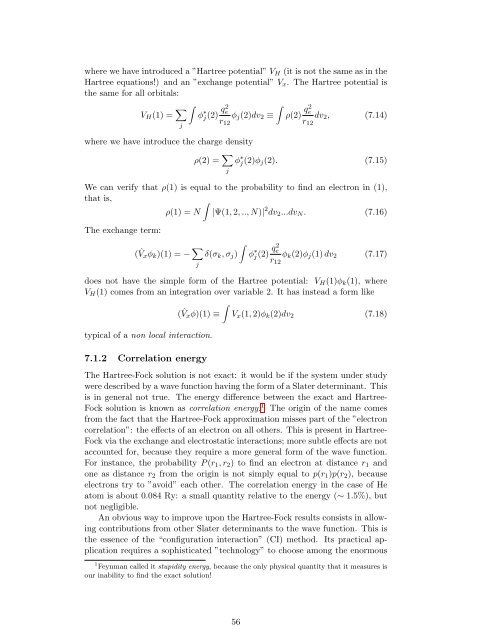Numerical Methods in Quantum Mechanics - Dipartimento di Fisica
Numerical Methods in Quantum Mechanics - Dipartimento di Fisica
Numerical Methods in Quantum Mechanics - Dipartimento di Fisica
You also want an ePaper? Increase the reach of your titles
YUMPU automatically turns print PDFs into web optimized ePapers that Google loves.
where we have <strong>in</strong>troduced a ”Hartree potential” V H (it is not the same as <strong>in</strong> the<br />
Hartree equations!) and an ”exchange potential” V x . The Hartree potential is<br />
the same for all orbitals:<br />
V H (1) = ∑ j<br />
∫<br />
∫<br />
φ ∗ j(2) q2 e<br />
φ j (2)dv 2 ≡<br />
r 12<br />
where we have <strong>in</strong>troduce the charge density<br />
ρ(2) q2 e<br />
r 12<br />
dv 2 , (7.14)<br />
ρ(2) = ∑ j<br />
φ ∗ j(2)φ j (2). (7.15)<br />
We can verify that ρ(1) is equal to the probability to f<strong>in</strong>d an electron <strong>in</strong> (1),<br />
that is,<br />
∫<br />
ρ(1) = N |Ψ(1, 2, .., N)| 2 dv 2 ...dv N . (7.16)<br />
The exchange term:<br />
( ˆV x φ k )(1) = − ∑ j<br />
∫<br />
δ(σ k , σ j )<br />
φ ∗ j(2) q2 e<br />
r 12<br />
φ k (2)φ j (1) dv 2 (7.17)<br />
does not have the simple form of the Hartree potential: V H (1)φ k (1), where<br />
V H (1) comes from an <strong>in</strong>tegration over variable 2. It has <strong>in</strong>stead a form like<br />
∫<br />
( ˆV x φ)(1) ≡ V x (1, 2)φ k (2)dv 2 (7.18)<br />
typical of a non local <strong>in</strong>teraction.<br />
7.1.2 Correlation energy<br />
The Hartree-Fock solution is not exact: it would be if the system under study<br />
were described by a wave function hav<strong>in</strong>g the form of a Slater determ<strong>in</strong>ant. This<br />
is <strong>in</strong> general not true. The energy <strong>di</strong>fference between the exact and Hartree-<br />
Fock solution is known as correlation energy. 1 The orig<strong>in</strong> of the name comes<br />
from the fact that the Hartree-Fock approximation misses part of the ”electron<br />
correlation”: the effects of an electron on all others. This is present <strong>in</strong> Hartree-<br />
Fock via the exchange and electrostatic <strong>in</strong>teractions; more subtle effects are not<br />
accounted for, because they require a more general form of the wave function.<br />
For <strong>in</strong>stance, the probability P (r 1 , r 2 ) to f<strong>in</strong>d an electron at <strong>di</strong>stance r 1 and<br />
one as <strong>di</strong>stance r 2 from the orig<strong>in</strong> is not simply equal to p(r 1 )p(r 2 ), because<br />
electrons try to ”avoid” each other. The correlation energy <strong>in</strong> the case of He<br />
atom is about 0.084 Ry: a small quantity relative to the energy (∼ 1.5%), but<br />
not negligible.<br />
An obvious way to improve upon the Hartree-Fock results consists <strong>in</strong> allow<strong>in</strong>g<br />
contributions from other Slater determ<strong>in</strong>ants to the wave function. This is<br />
the essence of the “configuration <strong>in</strong>teraction” (CI) method. Its practical application<br />
requires a sophisticated ”technology” to choose among the enormous<br />
1 Feynman called it stupi<strong>di</strong>ty energy, because the only physical quantity that it measures is<br />
our <strong>in</strong>ability to f<strong>in</strong>d the exact solution!<br />
56
















